

"island notes"
Curate Audiovisual Essays
The Isle of Barra - Eilean Bharraigh
by Dr Sarah MacKinnon
The Island Notes series is a curated space for audiovisual essays that offer a more creative way to write about a single island combining visual/audio and text with additional resources.
Is there a special island in your life that would make a great "Island Notes" piece? Contact us!
Island Notes Curators: Meng Qu and Evangelia Papoutsaki.
Introduction and History
The Isle of Barra, along with fourteen other inhabited islands, constitute the Outer Hebrides, an archipelago off the west coast of Scotland. The region is also known as the Western Isles, Na h-Eileanan an Iar (The Isles of the West), Eilean Siar (Western Isles) and Na h-Innse Gall (The Foreign Isles). The archipelago forms one of thirty-two local authority (council) areas in Scotland and has its own representatives in both the Scottish and British parliaments.
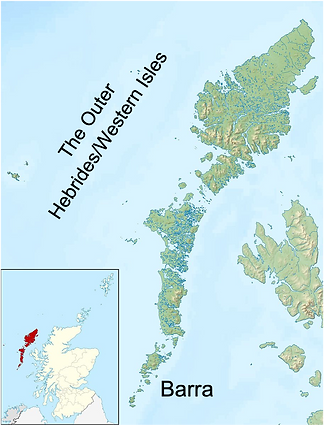
Barra is a small island, approximately six miles wide and eleven miles long, and is connected to the smaller island of Vatersay by a short causeway. Barra can be reached by air and sea. The twin otter airplane flies direct from Glasgow twice a day and lands on the ‘Traigh Mhòr’ (Big Beach) that acts as a runway between high tides. The journey takes an hour and the plane seats fourteen people. There is also a ferry between Barra and the town of Oban on the Scottish mainland, the journey takes approximately five hours and can be quite unreliable in winter months due to strong winds and swell. Barra is also connected by a smaller ferry to the neighbouring island of Eriskay.
There is limited archaeological evidence of who inhabited Barra before the eighth century. On the nearby island of Pabbay there is a decorated standing stone, suggesting that the Hebrides were inhabited by Iron Age Pictish tribes. Between the eighth and twelfth centuries the Hebrides were settled by various waves of Norse migration and their legacy remains to this day in many place names.
The Hebrides became part of the Kingdom of Scotland in 1266 and in the fifteenth century Barra became under the control of the MacNeil clan and the clan chief constructed Kisimul Castle. Barra was sold in 1838 to Scottish soldier, politician and slave owner John Gordon who proceeded to evict many islanders to make way for sheep farming, as was common during the Highland Clearances. This created a large diaspora of Barrafolk in Canada and the USA. The MacNeil’s retook ownership of Barra in 1937.
Map of the Outer Hebrides showing Barra
(Creative Commons - Contains Ordnance Survey data © Crown copyright )

Looking across the ‘runway’ of Barra’s airport which is submerged by the sea at high tide (Source: author)
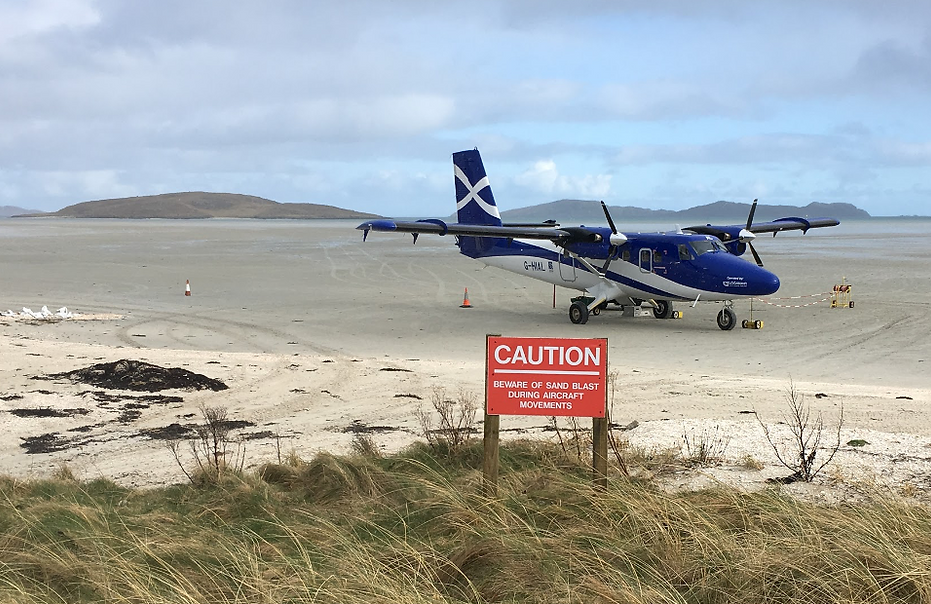
The Twin Otter plane that flies between Barra and Glasgow daily - flight time 1hr (Source: author)

Kisimul Castle sitting in the bay with the docked ferry at Castlebay pier (Source: author)
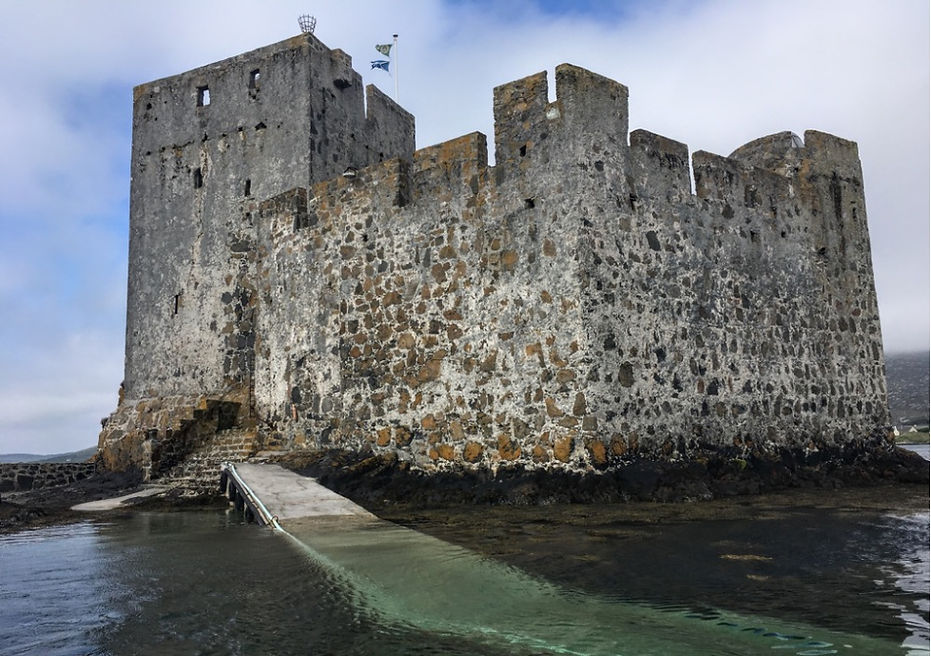
Close-up of the caste (Source: Author)
The People
The Outer Hebrides has a population of 26,830 (2018 estimate), while Barra and Vatersay together have a population of 1275 (2018 estimate). Approximately 60% of the population are bilingual speaking both English and Gàidhlig (Scottish Gaelic) and the majority of children on the island complete their primary education through the medium of Gàidhlig. Gàidhlig is a Celtic language that is classed as ‘definitely endangered’ by UNESCO, today there are 55,000 speakers in Scotland. 90% of Barra’s population are Roman Catholic which is different from the more northerly islands of Lewis and Harris which are overwhelmingly Protestant.
Barra’s cultural calendar includes the Fèis every Easter; children from around Scotland travel to Barra for classes in traditional instruments, Gaidhlig language classes as well as Highland Dancing. Barra held the first Fèis in Scotland and after it’s success many islands and towns across Scotland now hold their own Fèis each year. Each June there is the ‘Fishermen’s Mass’ where local boats are decorated with flags and bunting and are blessed by the local priest. After the Mass there is music and food for anyone who wishes. On the last Saturday of June there is the ‘Barrathon’; a half marathon around the main road on the island, after which there is a large buffet and dance for the community and runners. The music at these events is provided by local bands playing traditional Scottish, and particularly Hebridean, music and dancing involves Highland set dances. Other social activities include visiting the Screen Machine, a mobile cinema in an articulated truck that travels around the Highlands and Islands of Scotland, as well as the Barra Games.

The mobile cinema parked in the ferry car park (Source: author)
Flora and Fauna
The west side of the island is covered in ‘machair’, a low-lying plain on top of dune grassland that blooms every May in a carpet of daisies, orchids and buttercups. The island also blooms in ling heather in late Summer. The two pictures below show the author's land; the first in June covered in buttercups and the second in early September with the heather in bloom. There are very few trees on the island due to the severity of the wind (wind speeds are commonly 60-70mph in winter months but can reach up to 90mph during storms), and the soils are generally thin and acidic.
The most common animals on Barra are sheep (generally cheviots, or blackface) and Highland Cattle. There are few large predators, mostly just birds of prey and domestic cats, so chickens and other animals roam free and pests are in the form of rodents. Every September and October Barra is a popular destination for bird watchers to catch a glimpse of rare birds, such as the scarlet tanager, migrating south from the Arctic. The birds will often stop to rest in the few trees that Barra does have.
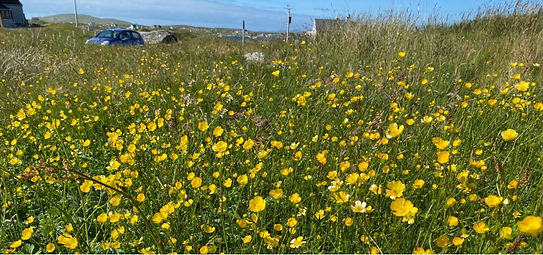
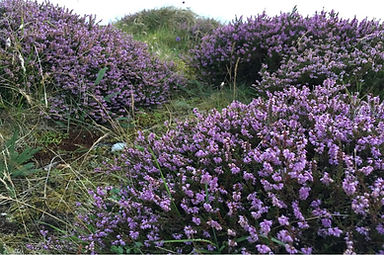
The Economy
The public sector is one of the largest employers on the island, mostly in the school, hospital and providing social care. Government jobs are considered stable, relatively well-paying with good benefits. The private sector is focused on three main industries: tourism, construction and food and drink manufacturing. The tourism industry consists of mostly small operations such as bed and breakfasts, camping sites, taxis and boat tours. There are four small hotels on the island, three cafes and a water-sports business. The tourism product of Barra is centred around the exploration of the landscape; walking on the beaches and over the hills, exploring the coast by kayak. Other activities include visiting the castle, watching the plane land on the beach and day trips to the now uninhabited islands of Mingulay and St Kilda. The wet and windy climate of Barra means that these outdoor activities are generally only appealing for a short period of time each year (May - September) and therefore the tourism industry is highly seasonal. There are few indoor activities that are income generating but some islanders are providing new experiences for tourists such as Gaelic choir performances.

The Traigh Eais, one of Barra’s many beautiful beaches (Source: author)
There is a growing food and drink manufacturing industry in Barra. Hebridean Toffee sells Scottish tablet, a mixture of crystallized sugar, butter and condensed milk, while seafood processing plant Barratlantic employs fifty people in the factory and forty-five fishermen. Most fish is exported to continental Europe but has faced challenges recently due to issues with Brexit. There is also a gin distillery called Barra Gin that is expanding into whisky production. As with other manufacturing businesses in the Hebrides, these companies do not have a sufficient domestic economy of scale, instead they have to focus on external markets outside the island. This incurs transport costs on the ferry and so these companies cannot compete with low-priced products and instead adopt a strategy of premiumization that uses branding and marketing relying on the appealing aspects of Barra’s cold-water islandess.
A combination of buildings needing regular repairs due to the climate and the increasing numbers of islanders returning to Barra after years studying and working on the mainland, means there is demand for the several construction companies and various self-employed tradespeople. Due to the costs of shipping in construction materials, building a house on Barra is approximately 30-40% more expensive than building the same home on the mainland and this can be a barrier to young couples and families moving to the island.
The third sector is an important provider of services on Barra as well as a source of employment. Gàradh a’ bhàg a tuath is a community run garden centre that ‘grows and sells local produce whilst helping people with special needs and reducing the carbon footprint of the local area’ (Gàradh website).

They also provide work experience for adults with disabilities in horticulture and in the cafe. The center was recently awarded £1 million of funding to build a new cafe and training building - a huge investment in a small community. Voluntary Action Barra and Vatersay produces the local newspaper and operates a community bus service called Bus Bharraigh. Although there is a limited public bus schedule, Bus Bharraigh takes seniors to do their shopping, transports people for special events (at the moment this includes vaccination appointments), and provides personal assistants for people with mobility issues. The community also installed a 900kw wind turbine at the very northern tip of the island in 2014 to generate income. There is also a local community shop, Buth Bharraigh, that sells local handicrafts, acts as a tourist information centre and a refillery to reduce plastic waste.
"Tourists waiting for the plane to land (Source: Author)".
Land Ownership
In 2000 descendents of Clan MacNeil agreed to lease Barra to Historic Scotland for 1,000 years for the annual rent of £1 and a bottle of whisky. In 2003 ownership transferred directly to the Scottish Government and islanders have the right to purchase the island from the government, if they so choose. Islanders generally rent their land from the government in a form of land tenure that is common across the northern region of Scotland, called ‘crofting’ . Each croft is a narrow parcel of land, generally stretching from the fertile coast to the boggy interior hills. A crofter is someone who practises small-scale, mostly subsistence, agriculture on their croft. Each croft also has access to an area of ‘common grazing’ on the hills for sheep during the winter. Common grazing can also be found on nearby uninhabited islands and sheep must be ferried back and forth each year. Croft rent is low (approximately £15 per year) but comes with obligations, such as living within 32km of the croft and actively using it. Crofts are generally transferred between family members meaning land on Barra does not regularly become available for sale on the open market.

Loch a Duin in the centre of Barra supplies the island’s drinking water (Source: Author)
Issues of ‘Development’
In Barra, and across the Outer Hebrides as a whole, development is synonymous with stemming population decline. Between 1951 and 2001 the population of the Outer Hebrides decreased from 35,591 to 26,502 people (a 25% decrease), in the same period the population of Barra decreased from 1728 to 1078 (a 35% decrease). However the 2011 census offered a glimmer of hope with the Hebrides’ population increasing to 27,684 (up 4%) and Barra’s increased by 9% to 1174.
Other development issues include fuel poverty, with over 55% of all households in the Hebrides suffering from fuel poverty and 58% of all households being classed as energy inefficient. Also, food insecurity can be an issue, particularly in the winter months when ferries are repeatedly cancelled due to stormy weather. The island can go for more than a week without any fresh produce such as vegetables and milk. For more information on development issues in the Hebrides you can read my doctoral thesis here.


Photos of the island's only grocery store in January 2020 after a period of particularly bad weather that meant there was no ferry for more than a week. (Source: Author)
Bio
Rinn Sorcha Nìcfhionghain am PhD aice ann cruinn-eòlas eilein ann an 2014 aig Oilthigh Banrighe Beul Feirste. Bhon àm sin, tha i air pàipearan fhoillseachadh air cuspairean a thaobh eileanan, agus gu h-àraidh eileanan anns na meadhanan. Bha i na deasaiche airson cùis sonraichte den iris-aithris Coolabah a thaobh eileanan miotasach agus ficseanail. Tha an rannsachadh aice suidhichte anns na h-Innse Gall far a bheil i a' fuireach agus ag obair. Tha Sorcha an sàs ann an ath-bheòthachadh na Gàidhlig.
Sarah MacKinnon completed her PhD in island geography in 2014 at Queen's University Belfast. Since then she has published papers with island-related themes, and particularly media representations of islands. She has also acted as a special issue editor for a thematic edition of the Coolabah journal on mythical and fictional islands. Her research is often focused on the Outer Hebrides of Scotland where she lives and works. Sarah is involved in supporting revitalisation of the Scottish Gaelic language.
Publications
SR MacKinnon. 2016. STARGATE ATLANTIS: Islandness in the Pegasus Galaxy.Shima 10 (2)
SR MacKinnon. 2020. Seasteads and Aquapelagos: Introducing Nissology to Speculative-Fiction Studies. Fafnir – Nordic Journal of Science Fiction and Fantasy.
SR MacKinnon. 2017. MUSICAL PERFORMANCES IN THE HEBRIDEAN EXPERIENCE ECONOMY. Shima 11 (2).
SR MacKinnon and M Hill. 2021. BEYOND THE STUDIO: Embedding the island in music production on the Isle of Eigg. Shima 15 (2).
SR MacKinnon and M Hannan. 2017. Myth-making through music: The "Lost Songs" of St Kilda. Shima 11 (2), 2017
Further Reading:
History of Barra:
-
MacPhearson, J., (2018) Tales from Barra, Edinburgh: Birlinn
-
Kisimul Castle: https://www.historicenvironment.scot/visit-a-place/places/kisimul-castle/history/
-
Holden, T., Boardman, S., McNeill, T., Brann, M., Walker, B. and Morrison, J., 2017, November. Kisimul, Isle of Barra. Part 1: The Castle and the MacNeills. In Proceedings of the Society of Antiquaries of Scotland (Vol. 146, pp. 181-213).
-
Franklin, J. and Lochrie, J., 2018, November. Kisimul, Isle of Barra part 2. In Proceedings of the Society of Antiquaries of Scotland (Vol. 147, pp. 49-72).
General Barra information:
-
Local newspaper: https://www.facebook.com/GuthBharraidh/
-
Local tourism website: http://www.isleofbarra.com/
-
Instagram: @islandsarah
The Outer Hebrides:
-
Annual socio-economic updates for the Outer Hebrides: https://www.cne-siar.gov.uk/strategy-performance-and-research/outer-hebrides-factfile/socio-economic-updates/
-
Outer Hebrides Factfile: https://www.cne-siar.gov.uk/media/15821/2020-fact-card-final.pdf
-
2017 Tourism Survey: https://www.visitscotland.org/research-insights/regions/outer-hebrides
-
Historic Sights: https://www.historicenvironment.scot/visit-a-place/search-results?r=512
-
Hutchinson, R., (2003) The Soap Man: Lewis, Harris and Lord Leverhulme, Birlinn: Edinburgh
-
Steele, T., (2011) The Life and Death of St Kilda, HarperCollins: London
-
Wightman, S., (2013) The Poor Had No Lawyers: Who Owns Scotland and How They Got it, Birlinn: Edinburgh
Scottish Gaelic:
-
Course for beginners, intermediate, and advanced learners : https://learngaelic.scot/index.jsp
-
The Gàidhlig college on the Isle of Skye (part of the University of the Highlands and Islands): http://www.smo.uhi.ac.uk/en/
-
Clips of Gàidhlig being spoken: https://www.youtube.com/watch?v=BiP0IaMcSNo&list=PLomnEwtqhZDcpB0N2B0WdR6p_BqrXExfz
-
BBC News in Gàidhlig: https://www.bbc.co.uk/naidheachdan
-
Famous Gàidhlig songs:
-
Manran with ‘Latha Matha’: https://www.youtube.com/watch?v=Yg9xA855s_A
-
Runrig with ‘Alba’: https://www.youtube.com/watch?v=FIjBcSQkMYE
-
Hannah Beaton & Norrie MacIver with ‘Griogal Cridhe’ : https://www.youtube.com/watch?v=WV7TPzNOuGk

